We love the idea of setting up a playroom for kids so that our children have their own space. But not all of us have an entire room to spare for play. Still, that doesn’t mean you need to sacrifice half your living room or give up your dining room table. There are so many ways to create an amazing playroom for your kids in a small space and contain the mess (er…creativity!) whether you’re an apartment dweller or just in a home with smaller rooms — or less space to spare.
So, we’ve put together 8 simple tips for how to set up a playroom for kids, especially when you don’t have a lot of space to spare. Think of the end result as a gift for your kids, and yourself.
Hello, sanity saver.
This post contains affiliate links and some purchases may help support our team at no additional cost to you.
Top image: Uncle Goose blocks available on Amazon
Image: Tim Pierce via Compfight cc
Playroom Ideas for Small Spaces
1. To set up a playroom, remember that everything needs a home
When you’re dealing with a small space, it’s super important to follow the mantra of many organizational gurus: Everything needs its own home. Or hey, its own nook as the case may be. A lot of clutter occurs when you don’t know where to put anything or when it feels like it doesn’t “go” — so crayons are left on the bookshelves, books end up in stacks on the living room floor, and craft supplies are everywhere. Sound familiar?
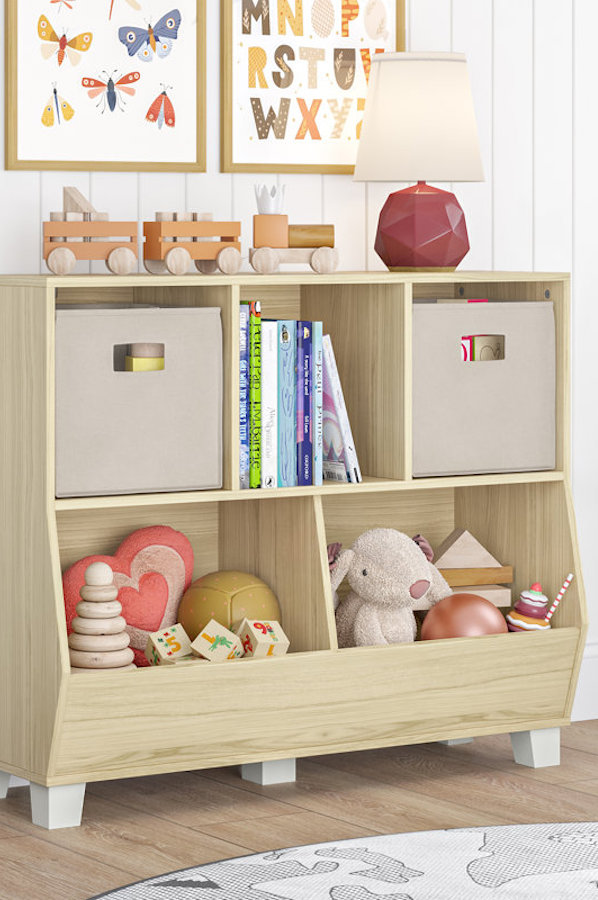
We love how you can specifically turn even a small corner of a living room into a dedicated play space for your child with a small multi-cubby organizer for toys and books like this one at Wayfair. It makes it clear that all children’s toys and items go specifically in this area, which is perfect for kids without a lot of stuff just yet.
When kids get older, we turn to cubby cubes filled with bins. Lots and lots of bins.
We’ve always been big fans of using labeled bins as a resting place for toys, craft supplies, doll clothes — nearly anything at all. Baskets work too.
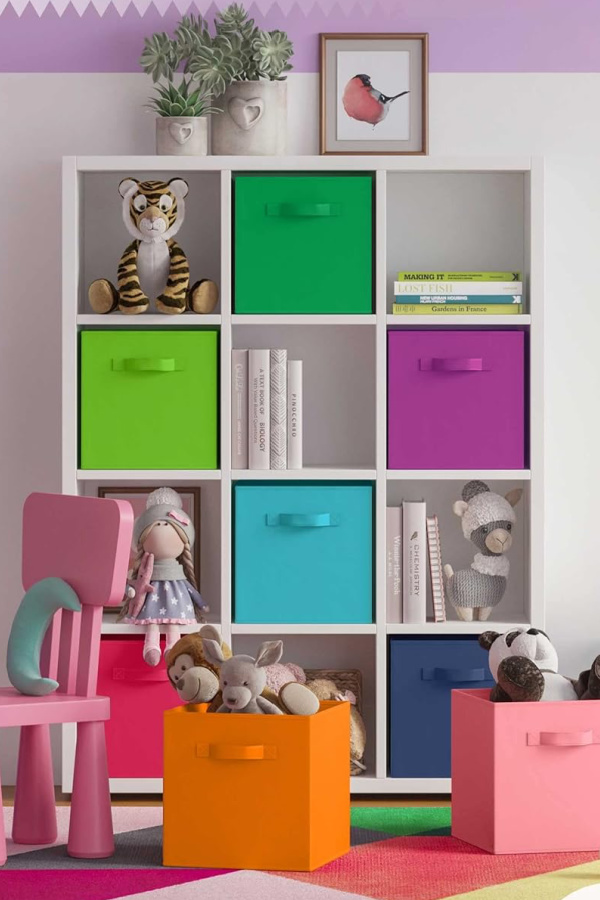
Color-coordinated rows of labeled bins are a great idea for small spaces since the symmetrical rows of shelving keep everything looking unified, and the clutter of tiny items remains hidden behind the bins. All you need is an 8-cube bookshelf (or fewer cubes, if you prefer) like this one found at Target, then add in two sets of collapsible fabric storage bins that match your decor — say grey and orange. You can also use colorful storage bins (shown above) which we found on Amazon, if it goes better with your decor. Or try an affordable ready-made toy storage shelving unit with bins.
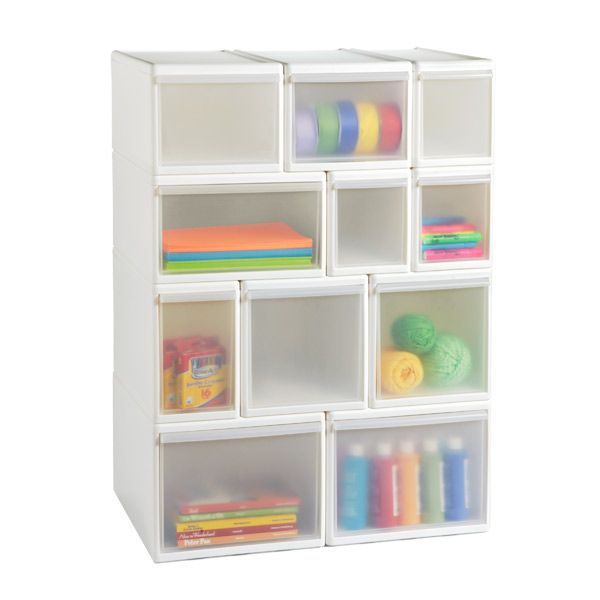
That said, some kids need to see what they have to be more inclined to reach for it, in which case, labeling clear bins is a smart alternative to fabric. Check out these affordable, modular translucent storage drawers at the Container Store for a ready-made solution.

We also like the Montessori-inspired playroom organization idea from An Inviting Home (no longer online), which is incredibly realistic for the way most of us live. As in, our homes don’t look like they’re made to be photographed for a design magazine.) Great way to maximize the use of a wall shelving unit — good combo of translucent toy storage, color-coded bins, and open shelving for books.
With multiple kids using this space, the parents smartly arranged everything based on age, with the items for smaller kids on the bottom, and toys and games for the bigger kids up top. We also love the colorful graphic labels marked with images of game pieces or puzzle pieces — perfect for toddlers who aren’t reading just yet — our change up the rotations to keep newer items at eye level.
Another trick is to color code the bins so kids learn that trains go in the blue bin, blocks go in the green bin and so on.
Whichever method of organization you choose, just be sure you make it easy enough for kids to know what belongs where, so that they can do more of the organizing and putting away on their own.
2. Use all of your walls, even the corners
If you don’t have a ton of floor space, get creative and work up! A terrific tip is to display and store items going all the way up the walls. Shelves can never be too tall (just make sure they’re safely anchored) since you can use the uppermost shelves for storage or decor; just because kids can only reach so far doesn’t mean your storage shelving has to stop there.
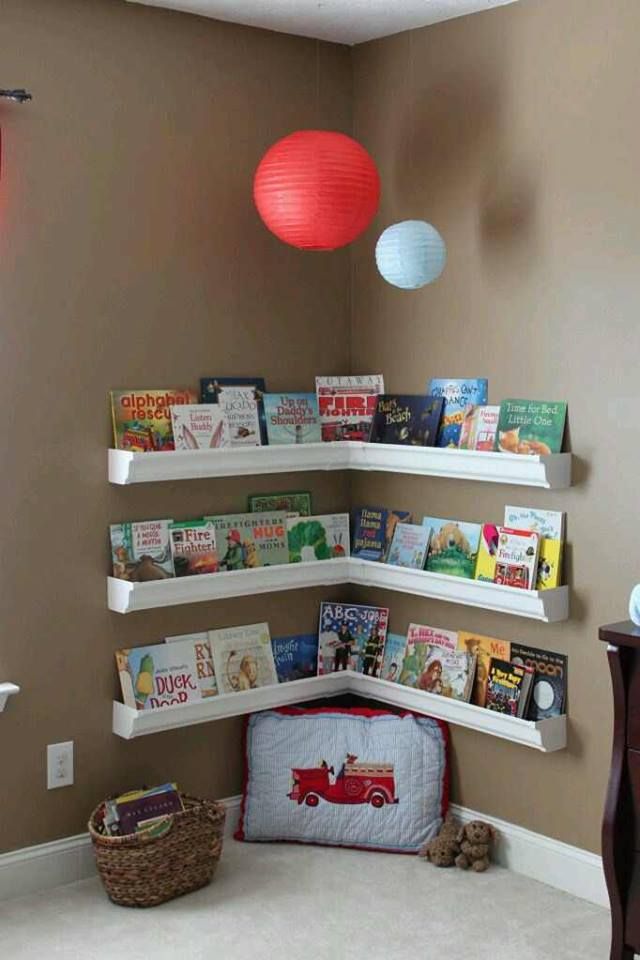
It’s also smart to maximize corners. If all you have is a corner of a living room or dining room for your child’s play space, open shelving made for corners can be a brilliant solution for books, stuffed animals, small toys, or to display artwork. Plus, cleanup is a snap! If you can spare a small footprint in the corner, thiseend-cap corner shelf is great for books (provided it’s properly secured to the wall of course).
3. Not enough floor space to set up a playroom? Hang it!
You can always hang items to get them off the ground and give your child more play space. Especially if you don’t have a lot of floor space to spare, and there are a few ways to do this.
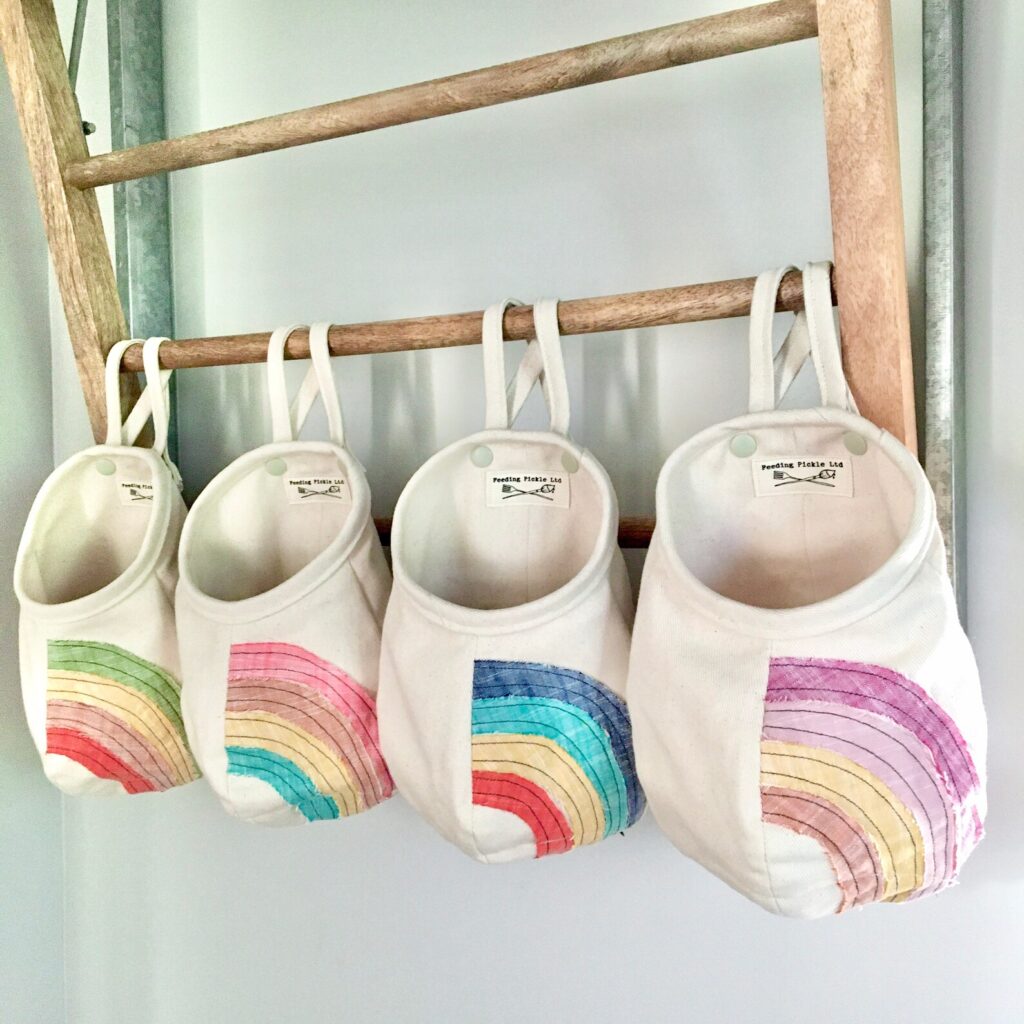
We love these hanging rainbow toy bags from the popular Feeding Pickle Etsy shop. So easy to reach in — or just toss stuff in for clean up!

A macrame toy hammock is perfect for kids with lots of plush toys — and lots of imagination. This one is lovingly handmade by Curiosity By Audrey on Etsy. Hey, those animals have to go somewhere after each tea party, and we’d like to leave a little room for our kids in their beds.
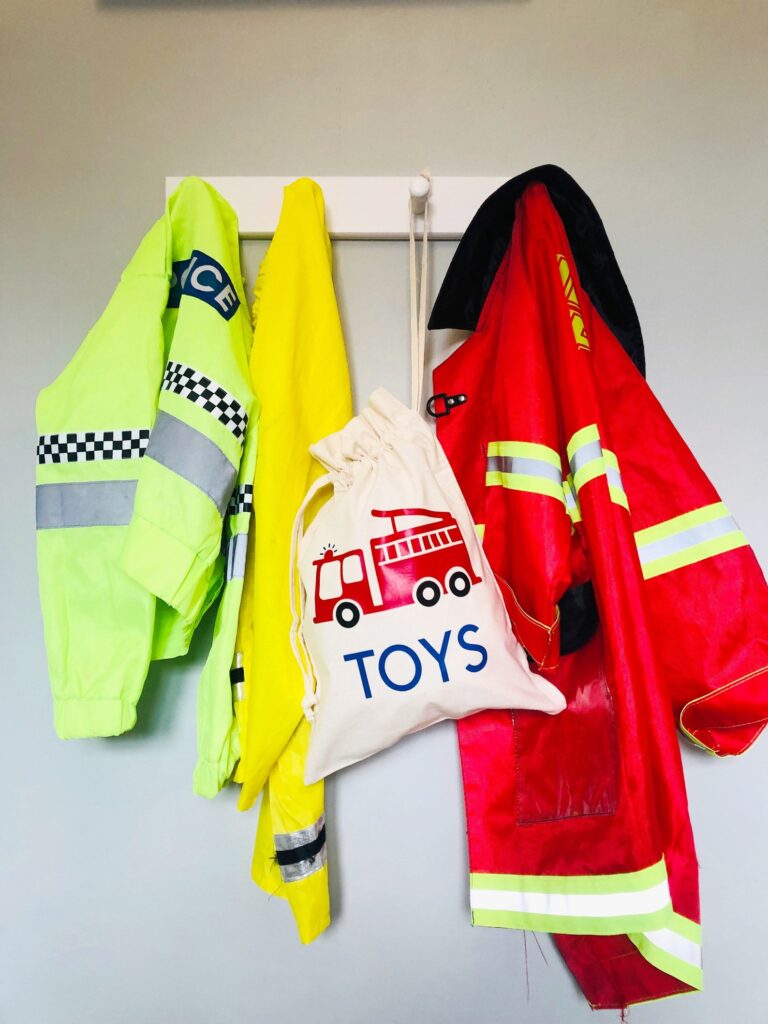
A drawstring toy bag can also be a big help, like these personalized bags from Sage & Cinder Co. They can personalize the colors and the label, so you could have one for LEGO bricks, one for blocks, one for dolls, and so on. It makes clean up a cinch.
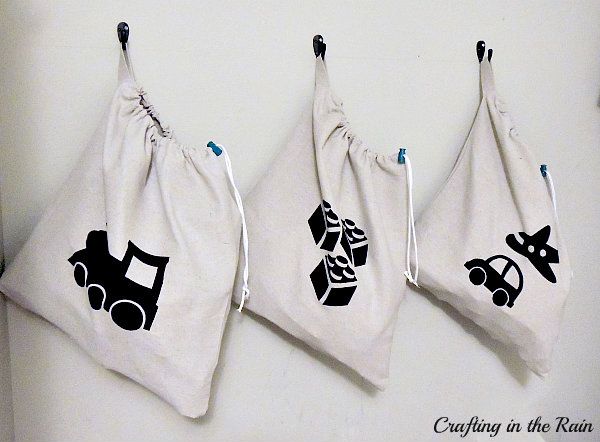
If you want to DIY, Craftaholics Anonymous offers a hanging toy bag tutorial and the results look so cool and graphic. Especially for toddlers who are not yet readers. Hang the bags on sturdy wall hooks or a mounted coat rack so kids can just pull down their toy trucks, LEGOs, dress-up clothes, or whatever they need in their play space. Then hang them up again for easy clean-up.
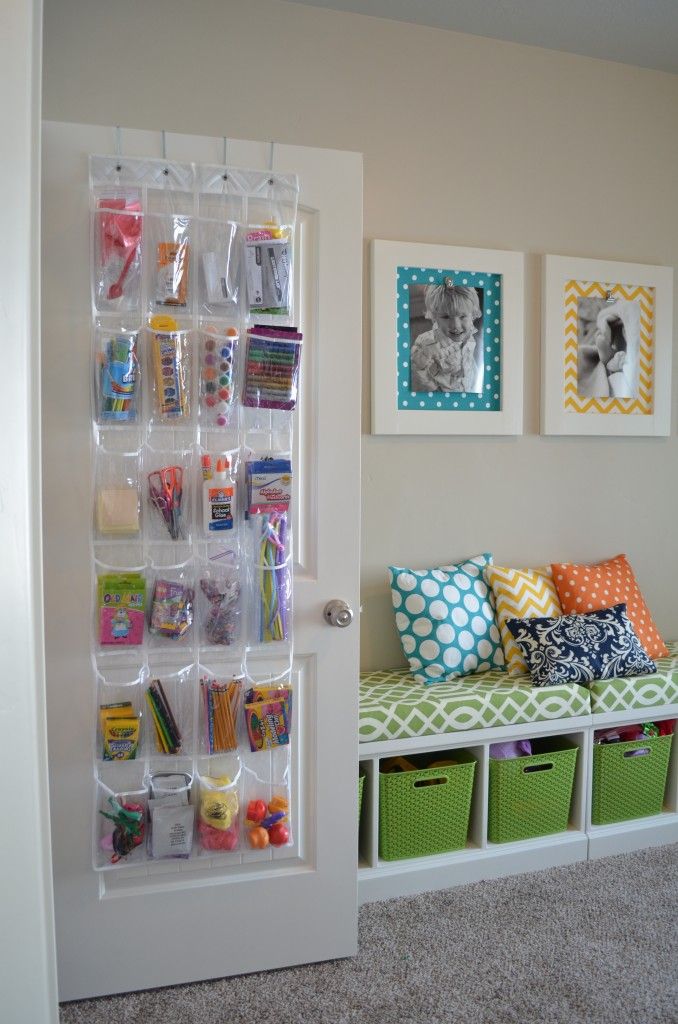
The behind-the-door storage trick is one of our all-time favorites. We wish we could find the original source for this fantastic look at how much a hanging shoe bag on the inside of the door can hold! A clear hanging pantry organizer or simple clear over-the-door shoe organizer is basically all you need! Though we would recommend you keep a sturdy, kid-friendly step stool or standing tower nearby so kids can reach the top bags safely. (Or hey, maybe that’s where you keep your permanent markers and acrylic paints.)
4. Look for items that do double duty in a kid’s play space
Whether it’s a desk that converts to a play table, or an ottoman that flips open to reveal storage under the cushion, we are tremendous fans of items that do double duty, especially when you’re working with a small room.

Take the VTech Touch and Learn 4-in-1 Activity Desk for example, which is a terrific space saver. You’d never know that tiny, kid-sized desktop is filled with so much to do; flip up the desktop and you’ve got a chalkboard or an art station for even more freeform creative play. You can also purchase expansion packs so it grows with your kids as their skills and interests change. Plus, look at all that storage for chalk, crayons, paint, and more. Bonus: when you flip the desk back, it’s all out of sight. Whoo!
5. Rotate playroom toys. Start yesterday.
When you’re accommodating a small space, there’s just no way you can keep a growing child’s growing collection of toys out in its entirety. Or at least not with your sanity intact if you need some semblance of organization and order in your home to function.
We’re huge advocates of rotating your kids’ toys — it’s a trick we still use, even for our tweens. Essentially you stash some of their toys, games, or craft supplies in a closet, basement, or other storage area. The rest you keep in their play area. This way, they’ll be less overwhelmed with choices, and when they need some “new” toys you can just “shop your own closet” and bring out that board game they got for their birthday or those coloring books that never got used on the last road trip.
It feels exciting, and yes, it saves immensely on space.
Parents Magaze has a pretty specific system for rotating your children’s toys, which is helpful when you have lots of them. But as a shortcut, you can also just grab a bunch of plastic bins (yes, we know — again with the bins!) and toss in a handful of items that your kids haven’t played with for a while to stash elsewhere. You don’t even need a “cute” storage solution — any heavy-duty storage bin will be fine.
6. Use modular flooring or a kid-friendly carpet as a divider to create a play area space
When you don’t have a separate room that can be used as a playroom, a bright washable carpet from Ruggable (below) or a series of Flor tiles can be a fantastic way to designate it as a dedicated play area. It also keeps a smaller room feeling open, as opposed to using a screen or a wall unit as a divider.
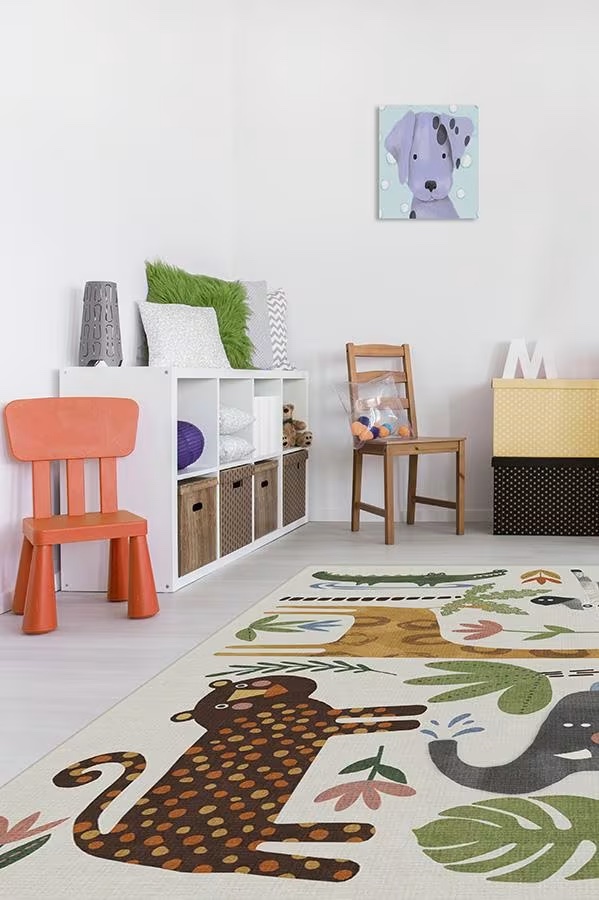
Kids will easily understand “animal rug = my area, other rug = grownup area.”
7. Let your kids’ own artwork serve as play room inspiration

When you’re creating a children’s space specifically meant for creating, discovering, and learning through play, the greatest inspiration might not be a poster with a beautiful quote about play — but the results of your kid’s own creativity.
There are lots of cool ways to decorate with their own artwork that isn’t too precious: Hang with clothespins from string, banner style. Tuck it into clipboards which you can nail onto the wall. Pin it onto some big squares of chunky corkboard. Or use magnetic poster frame hangers, which are designed to make it easy to change up the art it’s holding.
Bonus: it’s a great way for you to get all of the art pieces off your fridge (and perhaps, strewn about the rest of your house) and consolidate them into one very welcome area of the house.
8. Make sure everything in a small playroom is meant for play
As much as you might like your child’s playroom to look like a gorgeous, Instagram-ready masterpiece of decor, filled with fabulous antique toys and gorgeous framed artwork, it is…well, a playroom. And especially if it’s a small room, there just isn’t a lot of room for the precious stuff that may look sweet in a photo online but isn’t so practical in real life.
In other words, you’re not furnishing a museum here! So be sure your child’s play space is filled with the toys and dolls they really play with, books they really read, crafts they really use, costumes they really wear, play sets they really enjoy. They are kids after all.
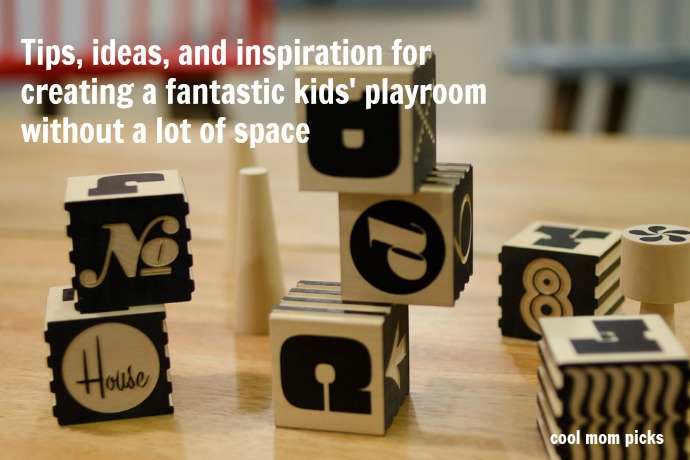




I love the tips and ideas in this article of how to set up a playroom in a small space. I really liked the magnetic frame for displaying artwork. I’m going to have to get one those!
My little ones have had #4 VTech table for years bc my father bought it for them when they were far too young lol Now that they know everything on the mats they’ve moved on. I had no idea there were more! Can’t wait to order these and surprise my littles!! Thanks. PS Oh yea and I was looking for some ideas on using a classroom over the door storage pc just like the clear one here. Wonderful tips!!